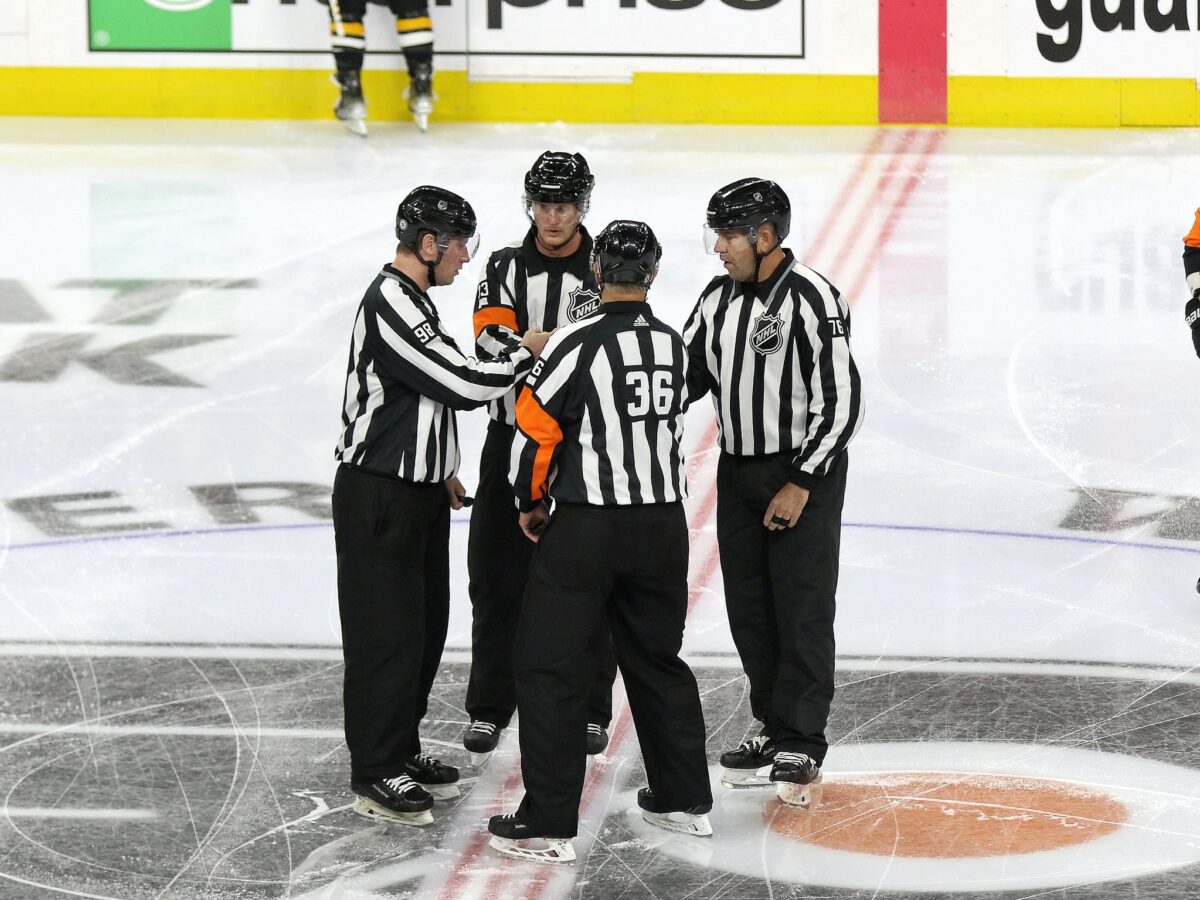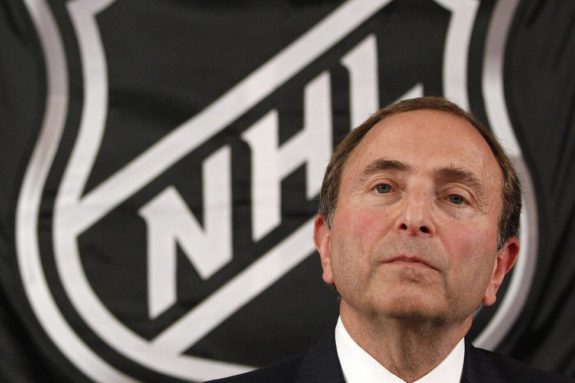Offside. You know what that is, right? Of course you do. Your team has likely encountered it several times per game. And if you’re really lucky (or actually extremely unlucky), it’s helped decide outcomes of recent games you’re interested in. But you as a student of the game know what offside is.
Good news. You’re already doing better than the NHL in recent games just knowing what offside is. Thanks to some circumstances for a couple different teams, it seems the NHL needs to learn what is and isn’t offside.
The fact that we even have to talk about this should concern you. The NHL clearly states in the rulebook what offside is supposed to be. They even have “safeguards” in place to ensure the rule is enforced correctly. Heck they even have replay if a call is missed on the ice and a goal is scored thanks to coach’s challenges.
But if you’re a fan of the Columbus Blue Jackets or Buffalo Sabres, you have questions right now. It’s absolutely within your right to have these questions. But this goes beyond these two teams. It goes way beyond that actually. When the integrity of the game is called into question, there’s a serious problem. Let’s lay out what’s going on for you.
Setting the Scene
First let’s consult with the rulebook and define what offside is. According to rule 83.1, offside is defined as follows.
A player is on-side when either of his skates are in contact with the blue line, or on his own side of the line, at the instant the puck completely crosses the leading edge of the blue line.
On his own side of the line shall be defined by a “plane” of the blue line which shall extend from the leading edge of the blue line upwards. If a player’s skate has yet to break the “plane” prior to the puck completely crossing the leading edge, he is deemed to be on-side for the purpose of the off-side rule.
A player actually controlling the puck who shall cross the line ahead of the puck shall not be considered “off-side,” provided he had possession and control of the puck prior to his skates crossing the leading edge of the blue line.

So we know what offside is. We know that the NHL updated this rule to include “breaking the plane.” But two scenarios have played out in recent weeks that deserve our full attention.
Columbus Blue Jackets & Missed Offside
The Blue Jackets in recent games have had an interesting trend develop. They’ve scored goals only to have them taken off the board due to offside. That seems normal, doesn’t it? A team will challenge the play and it was found to be offside. Nothing to see here, right?
Well, not exactly. This has happened to the Blue Jackets on five (5) different occasions in recent games. FIVE. Here is the list of recently challenged goals that were eventually reversed due to offside.
- Nov 26 vs. Vancouver. 1-0 goal was disallowed after challenge.
- Nov 30 vs. Nashville. 3-1 goal was disallowed after challenge.
- Dec 4 vs. Washington. 2-1 goal was disallowed after challenge.
- Dec 5 vs. San Jose. 6-4 goal was disallowed after challenge.
- Dec 9 vs. Anaheim. 2-1 goal was disallowed after challenge.
This begs an obvious question. How are the linesman missing so many offside calls?
Review is there to ensure the rule is enforced correctly. In that aspect, the rule is working as intended. But, the linesmen have a responsibility to enforce the rulebook as they see plays develop on the ice. To miss five offside calls in short order like this is unacceptable. Perhaps the linesmen need to learn what is and isn’t offside.
You Might Also Like
- A Hockey Fan’s Travel Guide to New York City
- 10 NHL Storylines to Watch for in 2024-25
- NHL’s 5 Most Underrated General Managers
- Are NHL Players the Toughest Athletes?
- Matt Rempe Is Choosing a Dangerous Path to NHL Success
But that’s not all. Let’s quickly revisit the game where the Blue Jackets played the Golden Knights. With the score 2-2 in the third period, the Golden Knights scored the eventual game-winning goal. It was challenged by coach Brad Larsen for offside.
The play was offside on replay. However the puck left the zone so it could no longer be called. The play was allowed to stand. However the linesman missed the original call and it ultimately decided a game.
This is where the problem with missed calls hurts not only the teams, but the league as a whole. You could argue that the linesman won’t catch every offside. You would be correct. They’re not perfect. The issue here is the frequency of these missed calls. Missing 1-2 calls here or there will happen. Missing six calls of varying degrees since Thanksgiving though? It can’t happen.
That’s just scenario one. Now we’ll switch over and talk about what happened with the Sabres against the Rangers. If you thought what happened to the Blue Jackets was bad, you haven’t seen anything yet.
A League Review Gone Wrong
The Sabres and Rangers were in a tight 2-1 game late in the third period with the Sabres looking for a tying goal. They got it. Victor Olofsson scored with 57 seconds left in regulation to make it 2-2. Or at least so we thought.
Because of the time of the goal scored being so late in the game, the league called for a review of the goal to determine if it was offside. Keep this in mind. The Rangers didn’t challenge the call.
Upon review at that moment, they determined that Rasmus Dahlin was offside. The goal comes off the board and the Rangers defeat the Sabres 2-1. That’s all well and good, except for one important fact. Dahlin was actually not offside.
A closer look at the replay shows that the officials should have reviewed if Olofsson touched the puck before Dahlin tagged up. It was inconclusive. Under NHL standards, when a play is inconclusive, the original call on the ice stands.
The NHL released a statement on Saturday admitting the wrong call was made and that video replays could not “definitively determine” whether the Sabres were offside entering the zone. Are you serious right now? How does this happen?
Like the Blue Jackets’ missed offside against the Golden Knights, this one with the Sabres clearly decided the outcome of a game. That alone should bother anyone with interest in the NHL.
Down Stream Effects
If you’re a fan, can you trust that the league will consistently get the call right? Clearly based on these recent examples, trust is an issue. The safeguards put in place to ensure the right call will be made hasn’t worked. It cost the Sabres points in the standings. It potentially cost the Blue Jackets points in the standings (assuming they got to overtime.) These calls could eventually determine playoffs spots if we’re messing with points here.
If you’re one who gambles on the NHL, I’d have serious questions also. Would you risk your money on a league who can’t enforce the rule book correctly? Yeah, me neither. Gary Bettman has some serious questions to answer.

The thing that the NHL needs to realize is just how crucial each and every call is. They can decide games. They can dictate how the standings look. It can affect the perception they have in the eyes of their fans and other people who pay attention to them.
Here’s a question. What is the NHL going to do to ensure something like the end of Rangers/Sabres doesn’t happen again? They came out and admitted the error. But the thing they didn’t do is admit what they’ll do so a repeat performance doesn’t happen.
Remember the debacle with the Blue Jackets and Hurricanes from last season and the trainee in the replay booth who yelled it was offside? Yeah. Review booth issues have happened before and they’re still at risk of happening again. Let’s see a real plan put in place to protect the integrity of the game. If there’s anything the NHL needs right now, it’s to repair the broken trust between them and many folks who watch them.
This is fixable. The linesman need to make their calls more consistently. The NHL needs to ensure that their safeguards are in good working order and ready to perform when called upon. And quite frankly, all parties need to learn what is and isn’t offside.
Things like this cannot continue to happen.
